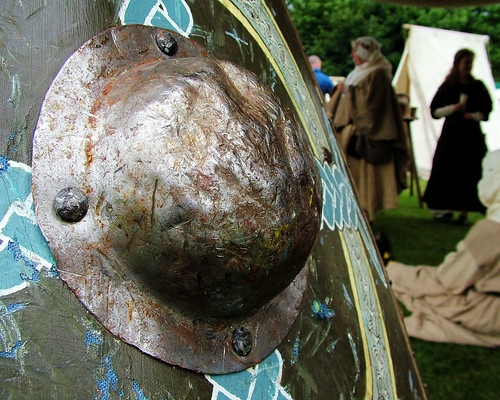The Shield from Bidford-on-Avon Grave 182 (Part 1)

While some of the Early Anglo-Saxon kingdoms have yielded much archaeology, and continue to yield extensive cemeteries and settlement sites for study, others are arguably less well served. The ancient kingdom of Mercia - of particular interest to our group, could in many ways be seen as such a case, and this presents a particular challenge when attempting to recreate the effects of this purportedly powerful, wealthy and sophisticated culture. Beyond the Staffordshire Hoard (itself mostly belonging to the mid-late 7th century and containing a very selective subset of items), at a glance one might be forgiven for thinking the Midlands lacked much in the way of early Anglo-Saxon archaeology.
In fact, there are a handful of archaeological sites which have yielded impressive finds, which are relevant to the earliest times of the Mercian kingdom - it is just that many were excavated in the early days of Anglo-Saxon archaeology, and their finds forgotten, lost, or hidden from view.
One such case; the large cemetery of Bidford-upon-Avon, Warwickshire, initially excavated between 1923 and 1924 (Humphreys et. al., 1925) sheds valuable light on early Anglo-Saxon Mercia and has yielded many impressive finds, including a great quantity of feminine items of decidedly Anglian (rather than Saxon) affinities, including one of the most impressive square-headed brooches ever found. Among a number of warrior graves, the most impressive item, however, was a shield-boss decorated in such a way as to make it entirely exceptional, artistically, and of a status (within the British Isles) second perhaps only to the kingly shield of Sutton-Hoo Mound 1.
The impressive shield-boss from Bidford-on-Avon grave 182 is not on public display, residing with the Shakespeare Birthplace Trust. To raise awareness of this find and explore what this piece of warrior gear may have looked like in its day, in 2012 we embarked on a lengthy process to reconstruct the shield, using authentic materials and techniques.
Nb. we are greatly indebted to the Shakespeare Birthplace Trust Collections Department, without who's help we could not have pieced together the story of the find. Examination of the original fragments in spring 2014, in particular, was crucial to achieving a representative reconstruction.


.jpg)

















